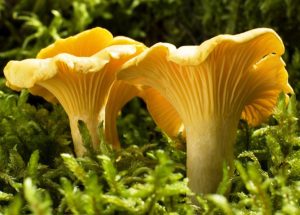Never eat a mushroom unless it is positively identified as edible. Use a good field guide, but don’t rely absolutely on pictures in books – differences between fungi can be difficult to spot. If possible, go out with an experienced guide. Mistakes can result in toxic reactions ranging from mild gastric upset to death. If in doubt, don’t eat it.
- Make sure you collect the entire mushroom including any underground parts, which sometimes hold vital identification information.
- Trim the soil off mushrooms before putting them in the basket. This is much easier than letting the gills or pores fill with dirt, then having to clean them at home.
- Eat only fresh mushrooms that are free from infestation by insects or larvae. Mushrooms can spoil, and eating any spoiled food can cause food poisoning or other adverse reaction.
- Thoroughly cook all mushrooms unless they are specifically known to be edible when raw. Some mushrooms contain toxins or gastro-intestinal irritants that must be destroyed by cooking (for example Honey Fungus).
- Eat mushrooms only in moderate quantities – mushrooms are not easily digested so overeating them can cause you to get ill.
- When trying a new mushroom for the first time, only eat a small portion. Don’t try any other new kinds for 48 hours – as with many kinds of food, some people are sensitive or allergic to mushrooms commonly eaten by other people. Individuals with known food allergies should be extra careful when trying mushrooms new to them, especially those species known to present problems to some people (for example Chicken of the Woods).
- Don’t pick mushrooms from contaminated habitats. These include polluted areas, chemically-treated lawns and gardens, ornamental trees, areas fouled by dogs and places close to main roads and motorways, landfills, toxic waste sites, agricultural fields or industrial areas. Contaminants will accumulate in mushrooms.
- Never assume that a wild mushroom you find abroad is the same species you know from Britain or vice-versa. Many serious cases of mushroom poisoning occur because visitors on holiday or immigrants unwittingly gather dangerous look-alike species not found in their native land (for example Macrolepiota venenata, not recorded in Britain, looks like a Shaggy Parasol but is toxic).
- Be conservative about feeding wild mushrooms to children, the elderly and the infirm. Avoid edible species known to cause adverse reactions in some people, and don’t let children and the elderly try any unfamiliar kind of wild mushroom until you have identified and eaten it without any adverse reactions.
- When trying a mushroom for the first time, save a few intact and uncooked, in the fridge for 48 hours. That way if there is a reaction, you can easily identify the source. If you put poisonous or unknown species in the fridge, make sure no one in the household is going to eat them accidently.
- Examine every specimen in every collection of mushrooms to avoid inadvertent mixing of different species. Even experienced mushroom collectors can make mistakes if they become careless and fill their baskets too quickly (for example mistaking the Yellow Stainer for Horse Mushroom). It is recommended to use separate containers for unknown species.
- When collecting mushrooms, avoid using plastic bags – the lack of air will accelerate the decomposition process and make the mushrooms mushy. It is recommended to use a basket instead.
Thanks to Clifford Davy of Forest Foragers.

